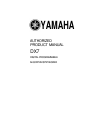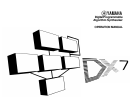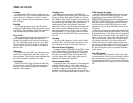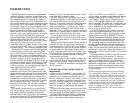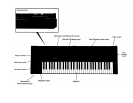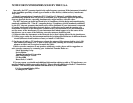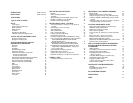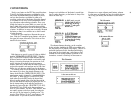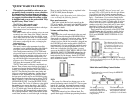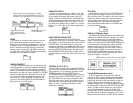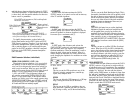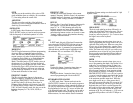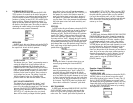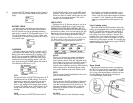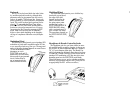INTRODUCTION
The DX7 is the world's first fully user programmable
and preset FM digital synthesizer. If you're used to con-
ventional synthesizers, one look at the DX7 will tell you
that something unique has happened. There are no
knobs: just two linear controls, one of which is for vol-
ume, an LED digital display a small alphanumeric liquid
crystal display (LCD), and a number of flat panel mem-
brane switches. There are no voltage controlled oscilla-
tors, amplifiers or filters (VCOs, VCAs, or VCFs), nor are
there any conventional envelope generators (EGs).
Instead, the DX7 utilizes a totally unique method to
create the richest, most naturally expressive sound avail-
able in any electronic keyboard. This special sound
generation technology is called FM Digital Synthesis. FM
Digital Synthesis enables the DX7 to create the over-
tones that would be present in an actual acoustic instru-
ment, and to vary them over time in a precise,
controllable manner to produce uncanny realism when
you're playing an acoustic voice — or to produce incred-
ible fantasy sounds — the possibilities are without limit.
Because the DX7 creates sounds differently than con-
ventional analog or purely digital synthesizers, you'll
have to spend some time re-educating yourself with the
aid of this manual. After you've become familiar with
the panel, a few new terms, and the general concept of
FM digital synthesis, you'll love the precision and tre-
mendous versatility at your disposal. If you're already an
experienced synthesist, you will soon be able to go right
for a particular sound. Whether you're a beginner or a
world class performer, you can enjoy the large library of
preset sounds that come with the DX7.
The DX7 is delivered ready to play, loaded with 32
beautifully voiced, useful, factory preset sounds. These
sounds can be instantly changed, or can be replaced by
additional factory-supplied sounds from a library of 128
that are supplied on special solid state cartridges. Liter-
ally hundreds of exciting sounds can be at your finger-
tips with just the press a few selector buttons. You don't
have to program a single thing... unless you want to.
Presets won't handle every job, and there's nothing that
says you have to use ours. You can make your own
voices.
The compact size and relatively few controls of the
DX7 can be deceiving. Almost every button and knob
have multiple functions (depending on the selected
operating mode) so that a total of some 168 parameters
can be altered. In fact, the DX7 has more programmabil-
ity than any synthesizers Yamaha has ever before
offered to the public, providing greater control over the
sound than large or modular systems.
The DX7 keyboard is fully polyphonic with 16-note
simultaneous capability, so the sustain of previous notes
will not be cut short when you're playing with all 10
fingers. It is also highly responsive to player expression.
The harder or faster a key is played, the louder the
initial attack of the note — just like a piano. Unlike a
piano, however, the degree of touch response is pro-
grammable... both in sensitivity to the speed (velocity) at
which the key is pressed, and in sensitivity to how hard
you press after the kit hits the stop (after touch).
You can program voices from scratch (using a voice
initialize function). If you like an existing voice, you can
edit it to make subtle changes, or transform its character
completely.
Because the DX7 employs unique FM tone generation
techniques and lets you program them with the preci-
sion and repeatability of digital control, you'll be able to
create voices that are a giant step beyond the capability
of former synthesizers. Pure sounds. Richly textured
sounds. Outer space sounds. Bold, heavy sounds. Sub-
tle, delicate sounds. Uncannily accurate acoustic sounds.
All are possible with the high fidelity that FM digital
tone generation can provide.
Once you've edited a voice or created an entirely new
one, you can store it in the internal memory and/or in
special solid state cartridges. A battery prevents loss of
memory — even after the instrument is unplugged from
the AC receptacle.
Up to 96 Voices Can Be "On Line" Ready for
Instant Recall
Voices (sounds or ''instruments") may be saved in 3
different ways with the DX7. As mentioned above, the
synthesizer has 32 internal voice memories that can
hold any combination of factory preset sounds or voices
you create. In addition to the internal memories, one of
two types of memory cartridges may be inserted in the
instrument for additional "on line" memory. Pushbuttons
enable you to select from the internal and cartridge
voices.
A total of 128 factory preset voices are provided. Obvi-
ously they all cannot fit in the 32 internal memories at
once; these voices are actually supplied to you stored in
2 solid state ROM (Read Only Memory) cartridges that
each hold 64 voices, arranged in two banks of 32. You
move a slide switch on the cartridge to gain access to
voices 1-32 in Bank A or 1-32 in Bank B — access for
playing, editing, or loading into the synthesizers internal
memories. Before the DX7 is shipped, 32 of the 128
voices called the "Master Group" are loaded from the
bank A of the
#3 ROM cartridge into the synthesizer's
internal memories. This means that a cartridge does not
have to be installed in order for you to open the carton,
plug in headphones or an amplifier/speaker system,
turn on power, and begin playing.
You can edit the preset voices, or make voices from
scratch, but you cannot permanently store your own
voices on the ROM cartridges. For this purpose, a third
storage method is provided: an EEPROM (Electrically
Eraseable Programmable Read Only Memory) cartridge
which, for simplicity, we call a RAM cartridge (Random
Access Memory). The RAM cartridges go in the same
slot as the ROM cartridges, and superficially they look
the same. However, because of the added complexity of
RAM memory, only 32 voices will fit in one of these car-
tridges. The slide switch on the RAM cartridge is actually
an additional "write protect" feature that prevents accci-
dental erasure of voices you have stored; it is not a bank
A-B
selector.
This arrangement lets you have a total of 96 voices at
your fingertips since you can have any 32 voices you
wish loaded in the internal memories, then install one
of the 64-voice ROM cartridges. You switch between
internal and cartridge voices with the press of a button,
and between cartridge banks A & B with a slide switch.
Of course, if you allow for changing cartridges, which
takes just a second, your live performance voice library
is really unlimited.
NOTE Portions of the front panel are used to illustrate
the text throughout this manual; it should be relatively
easy to see where these "spot" illustrations fit in the con-
text of the entire instrument if you are reading the man-
ual with the DX7 in front of you. If the instrument is not
handy we suggest opening this cover fully revealing an
overall front panel illustration that will remain visible as
you flip through the inside pages. Originally ROM car-
tridges were numbered
#
1 & 2. Later models were
shipped with ROM cartridges
#
3 & 4 instead. Both sets
have similar voices.



